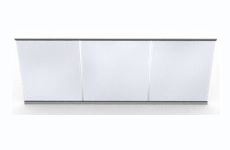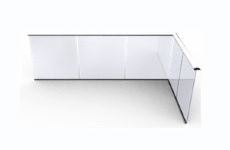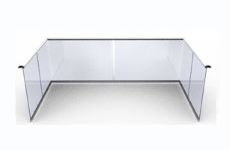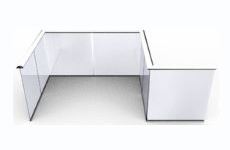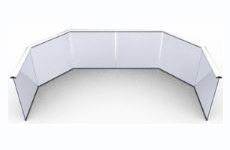Toughened Glass VS Laminated Glass: Which One is Best for My Balustrade?
To price your balustrade requirement first choose the shape most similar to yours
When it comes to selecting robust safety glass for your balustrade, you're faced with two choices: toughened or laminated glass.
At a glance, these two types might appear similar, but they differ in several aspects, especially in their manufacturing process and behaviour upon impact. While we offer toughened glass as the standard option, the decision of whether to go for toughened or laminated glass isn't cut and dry. To assist you, we've put together a practical guide that presents all the essential information. This will enable you to make an informed choice between toughened and laminated glass for your balustrade. Continue reading to learn more.
Striking Hybrid® Aerofoil Balustrade in the afternoon sun
What is Toughened Glass?
TToughened glass is glass that has undergone a heating and quick cooling process that transform the glass to be much more resistant to impact by as much as four times stronger than ordinary float glass. This enhanced strength is achieved through a process called tempering (also called toughening in the UK). In this process, standard float glass panels that have been cut to size and have had their edges polished is heated to an extremely high temperature (around 650 degrees C) and then rapidly cooled. The cooling process (also known as “quenching”) creates an exceptionally strong outer layer. This toughened outer layer provides the glass with significant resistance to impact and the ability to endure extreme temperature changes. A glass panel that is toughened will usually have a mark in one of the corners showing it has been toughened, etched into the glass.
What is Laminated Glass?
Laminated glass is made from two sheets of glass with a plastic interlayer between them. The interlayer is usually made from EVA (ethylene-vinyl acetate) or PVB (polyvinyl butyral). Similar to our toughened glass, the two glass sheets have been tempered and strengthened to be roughly four times more resilient than standard float glass. In the final stage of production, the glass and plastic interlayer are fused together using high heat and pressure.
Breakage
Safety remains the foremost priority in the realm of glass balustrades, which is why we employ glass that surpasses the UK Safety Requirements. However, it's essential to acknowledge that almost everything has a breaking point. Understanding the potential limitations of our safety glass and how a glass panel might respond to impact is crucial.
Toughened Glass
- The tempering process renders the glass highly durable, enabling the glass panel to withstand high-intensity impacts. In the unlikely event that it does break, it is designed to shatter into very small pieces, which is known as “breaks safely” as opposed to breaking into large shards or spikes. This is one of the reasons it’s called “safety glass”.
Toughened glass will break into many tiny pieces.
Laminated Glass
-
Laminated glass is a robust structure that requires considerable force to break. However, in the event that one of the two laminated panels breaks, it remains bonded to the second panel which did not break. The strength of the glass overall is dependent upon the thickness of the panels and if they are, or are not, themselves toughened. The thickness and makeup of the interlayer also has an effect on the permeability of the panel in case of breakage.
Laminated glass can in many cases can remain in situ even if one panel will break.
Available Glass Thickness
We offer a range of thicknesses for both our laminated and toughened glass, depending on the specific application..
Toughened Glass
- As a standard option, we provide 10mm toughened glass, which is suitable for our standard Juliet Balconies, Hybrid® Balustrades, Aerofoil Infinity Screen, and Orbit Privacy Screen systems.
- If necessary, we can also offer 12mm toughened glass, typically reserved for Privacy Screens in areas with high wind loads.
Thicker 12mm toughened glass providing shelter from wind and rain
Laminated Glass
- We offer both 10.8mm and 11.5mm laminated glass options, which are suitable for our standard Juliet Balconies, Hybrid® Balustrades, Aerofoil Infinity Screen, and Orbit Privacy Screen systems. These panels comprise two layers of 5mm toughened glass with either a 0.8mm or 1.5mm plastic membrane.
- For our Frameless Juliet Balconies and Frameless Glass Balustrade systems, we utilize a sturdier 21.5mm panel. This thicker, double-layered glass enhances the overall strength of the system.
- Furthermore, we provide a 25.5mm thick glass option for Frameless Glass Balustrades with a 1.5kN loading.
Two panels of toughened glass sandwiching a plastic interlayer
Security & Strength
Toughened Glass
- There’s a prevalent misconception that thicker laminated glass is stronger than a single 10mm toughened glass panel, but this isn't accurate. Contrary to common belief, laminated glass isn't as strong as the 10mm monolithic panel upon initial impact. The 10mm solid panel demands significantly more force to shatter and boasts approximately 20%-30% more strength compared to laminated glass of similar thickness.
- The tempering process not only enhances the glass's load bearing and breakage resistance but also provides remarkable thermal resilience to the glass panel.
Stunning view of rolling countryside from Hybrid® Aerofoil Balustrade
Laminated Glass
- If we compare the two in terms of security, toughened glass is notably stronger and requires significantly more force to break. However, when toughened glass shatters, it exposes the area formerly covered by the glass, creating a risk of someone potentially falling through the gap in the balustrade. On the other hand, laminated glass's unique structure ensures that shattered glass shards usually remain held together, protecting the exposed area.
- The resin's ability to support the glass without fragmenting or creating gaps also lessens the risk of injury from fallen glass shards on the ground. The sandwiched interlayer in laminated glass provides both structural integrity and a reduction in the transmission of harmful ultraviolet rays. The plastic interlayer offers UV protection by filtering out damaging rays, which can extend the lifespan of your garden furniture by minimizing fading and bleaching over time!
Maintenance
Toughened and laminated glass exhibit similar maintenance characteristics; both are intrinsically waterproof, resistant to wear, and capable of withstanding strong winds.
If you want to ensure the longest possible lifespan for whichever type of glass you choose, we recommend applying the BalcoNano® self-cleaning solution. Despite its smooth appearance, glass actually has a textured surface with small crevices where dirt, grime, and other deposits can accumulate. BalcoNano® applies a thin, transparent layer to the glass, creating a water-repellent surface that evens out the texture and prevents dirt from sticking. Once the coating is in place, minimal effort is required to keep your glass in pristine condition – an occasional quick wipe-down is all that's needed!
Laminated Glass
- One thing to keep in mind when opting for laminated glass is to ensure that the glass panels are not sitting in standing water, as this could lead to long-term delamination and visual deterioration. Make sure you establish adequate drainage on your balcony to prevent this issue.
Finishes
Even though toughened and laminated glass are well-known for their exceptional strength and durability, they also offer a high degree of flexibility in design and come with a versatile range of finishes. Both glass options can be easily tailored to your precise needs, whether you want to add a tint, opt for Obscure Glass, or have it cut into a specific shape or size.
Toughened Glass
If you require privacy glass for your outdoor area, toughened glass can be supplied as opaque glass. These are available as Satin Glass in 10mm or with 10% screen printing onto 12mm panels. These options offer a significant degree of privacy while still allowing ample light to filter through. This is an ideal solution if a portion of your balcony or garden faces neighbouring properties or public spaces.
An impressive high-rise of Satin Glass privacy screens
Laminated Glass
- You have the choice to order your laminated glass with an obscure interlayer, transforming it into Obscure Glass. This process involves replacing the transparent resin between the two glass panels with a matte, milky white translucent interlayer. This white interlayer allows light to filter through while preventing the visibility of shapes or figures behind the glass, ensuring complete privacy and protection from curious eyes.
- For those seeking to express themselves and add unique tones to their balustrade, the option of incorporating a coloured interlayer is available. This allows you to achieve your desired aesthetic. Whether you opt for a subtle or bold colour, all interlayer colorants consist of highly durable pigments and are designed to maintain their colour integrity over the years, even when exposed to direct sunlight.
A beautiful, tinted Balustrade
Price
So, you now have a solid understanding of what toughened and laminated glass can offer. Naturally, the final consideration is the price. Below, we provide a price indication, but it's advisable to discuss with our knowledgeable team, who will walk you through our competitive pricing and selection process.
Toughened Glass
- Toughened glass is a more budget-friendly option, which is why we offer it as standard for our traditional Juliet Balconies and Hybrid Balustrade systems. Since this glass is highly popular, we maintain a substantial inventory of it in our Surrey warehouse.
Laminated Glass
- Laminated glass can be more expensive when compared to our standard 10mm glass due to the complexity and extended length of the manufacturing process. To strengthen the glass and bond the glass with the interlayer, the panel is exposed to extreme heat and pressure – this process requires substantial amounts of fuel and energy, which contributes to the increased price tag.
- For our Frameless Juliet’s and Frameless Balustrades, we use 21.5mm as standard as the double-sheeted glass lends its increased strength to the system’s structure.
Glass types for residential building taller than 11m.
New regulations have come out since the wake of the Grenfell disaster in 2016. Fire regulations on external facades have been scrutinised and revised and new regulations have been published regarding the use of laminated glass in balustrades and balconies in high rise buildings.
These new regulations have sometimes been viewed in the industry as a “ban” on glass in high rise balconies, with some architects apparently led to believe it is now forbidden. Confusion on the new regulations has turned some designers away from glass balconies and balustrades, with some turning back to vertical steel railings as a substitute.
The truth is that glass balconies and balustrades are most certainly not banned in these settings. For clarity, we created an article that explains in detail what is - and what is not - allowed under the latest regulations. https://www.balconette.co.uk/glass-balustrade/articles/ban-on-laminated-glasses---can-glass-balustrades-be-used-on-high-rise-buildings
Contact Us
To learn more about our toughened and laminated safety glass, click here to connect with our Balconette experts, who will assist you through the selection process.
